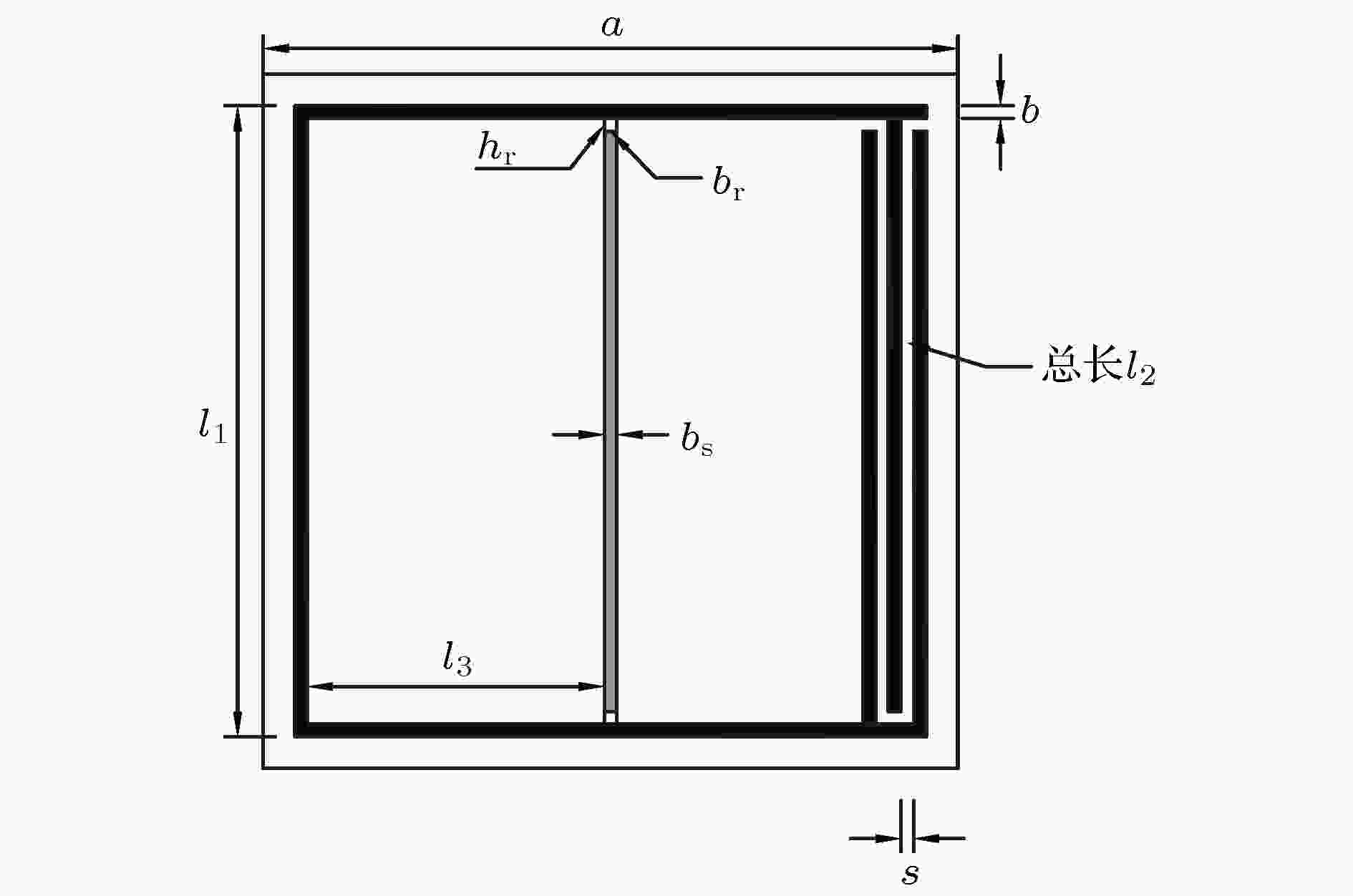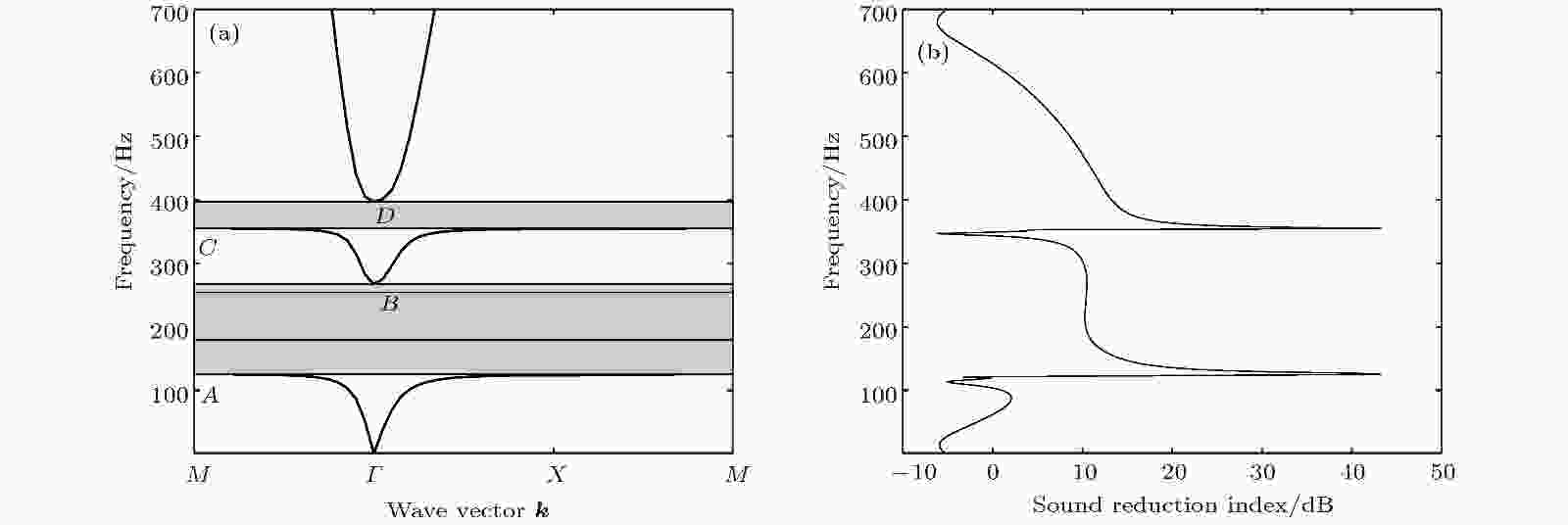全文HTML
--> --> -->这些研究对于提高Helmholtz结构隔声效果具有重要意义, 但仍只有空气参与振动, 等效振子质量难以进一步提高, 若需进一步降低其带隙下限, 往往需要增大结构尺寸, 限制了其在工程上的应用. 2016年, Abbad和Ahmed [16]将Helmholtz腔的上下壁换为钝化薄膜, 并研究了其隔声量相对于传统结构变化情况. 2018年, Zhu等[17]推导了穿孔板与薄膜耦合结构的吸声系数计算公式, 这种耦合结构同时利用了薄膜[18-20]和固/气结构隔声特性, 取得了良好效果.
本文设计了一种带弹性振子的Helmholtz型声子晶体, 对其带隙机理进行了详细分析, 建立了等效模型, 在6 cm的腔体尺寸下, 将带隙下限降至24.5 Hz, 相比于传统单腔单开口Helmholtz型声子晶体, 带隙下限降低了40%, 实现了小尺寸控制大波长, 扩大了其在工程上的应用范围.
 图 1 Helmholtz腔与弹性振子耦合结构横截面
图 1 Helmholtz腔与弹性振子耦合结构横截面Figure1. Cross section of Helmholtz resonator coupled with elastic oscillator structure
将腔体外边长固定为l1 = 60 mm, 腔壁厚度固定为b = 1 mm. 先利用理论计算方法对所选参数取值范围内所有可能组合进行遍历扫描(均以1 mm为间隔), 再利用有限元法进行验证和调整, 分别对Helmholtz腔与弹性振子耦合结构和其对应的传统Helmholtz腔结构进行求解, 其第一带隙下限最低时的参数组合及各参数取值范围如表1所列, 采用的材料参数列于表2, 得出其带隙结构如图2(a)所示.
| 名称 | a/mm | l2/mm | l3/mm | br/mm | hr/mm | bs/mm | 振子材料 |
| Helmholtz腔与弹性振子耦合结构带隙下限最低参数 | 61 [61, 65] | 50 [1, 1680] | 40 [1, 56] | 4 [1, 5] | 9 [1, 9] | 25 [1, 25] | 钢 |
| 传统Helmholtz腔结构带隙下限最低参数 | 61 [61, 65] | 848 [1, 1680] | — | — | — | — | — |
| 初始结构参数 | 65 | 50 | 28.5 | 1 | 1 | 1 | 铝 |
表1各结构参数组合
Table1.Combination of various structural parameters
 图 2 (a) Helmholtz腔与弹性振子耦合结构带隙图; (b) Helmholtz腔结构带隙图
图 2 (a) Helmholtz腔与弹性振子耦合结构带隙图; (b) Helmholtz腔结构带隙图Figure2. (a) Band diagram of the Helmholtz resonator coupled with elastic oscillator structure; (b) band diagram of the Helmholtz resonator structure
| 材料名称 | 硅橡胶 | 环氧树脂 | 碳 | 铝 | 钛 | 钢 |
| 密度/k·m–3 | 1300 | 1180 | 1750 | 2730 | 4540 | 7780 |
| 弹性模量/1010 Pa | 1.175 × 10–5 | 0.435 | 23.01 | 7.76 | 11.70 | 21.06 |
| 剪切模量/1010 Pa | 4 × 10–6 | 0.159 | 8.85 | 2.87 | 4.43 | 8.10 |
表2各材料参数
Table2.Material parameters
对于传统Helmholtz腔结构, 降低其第一带隙下限主要通过增大开口长度, 由于这样会使得腔体体积减小, 导致其第一带隙下限最低低至42.1 Hz(如图2(b)所示). 而对于Helmholtz腔与弹性振子耦合结构, 其第一、二带隙分别为24.5—47.7 Hz, 237.6—308.6 Hz (如图2(a)所示).
为探究Helmholtz腔与弹性振子耦合情况下的带隙机理, 设置初始结构参数如表1所列. 利用有限单元法得出其带隙结构如图3(a)所示, 从图中可以看出, 该结构在700 Hz以下存在两个带隙, 其中第一带隙为125.34—267.30 Hz, 第二带隙为355.13—397.22 Hz, 各带隙的起止点已在图中标出. 另外, 在179.17 Hz和254.69 Hz处出现了两条平直带.
 图 3 (a) Helmholtz腔与弹性振子耦合结构带隙图; (b) Helmholtz腔与弹性振子耦合结构隔声曲线
图 3 (a) Helmholtz腔与弹性振子耦合结构带隙图; (b) Helmholtz腔与弹性振子耦合结构隔声曲线Figure3. (a) Band diagram of the Helmholtz resonator coupled with elastic oscillator structure; (b) the transmission spectra of the Helmholtz resonator coupled with elastic oscillator structure
为研究该结构的隔声性能, 沿纵向串联3个元胞结构, 在结构的一端设置背景压力场, 并配置完美匹配层(PML), 利用声压模式的隔声量计算公式针对0—700 Hz范围内的声波进行隔声量计算:
 图 4 (a) A点, (b) B点, (c) C点, (d) D点的声场压力图
图 4 (a) A点, (b) B点, (c) C点, (d) D点的声场压力图Figure4. Sound pressure distribution diagrams of point A (a), B (b), C (c), and D (d).
在B点(模态B), 左腔声压为负值, 右腔及腔体外部声压为正值且外部声压最大. 表明此时振子与开口中空气做同向振动, 且声波可以在腔体外部传播, 由此对应带隙上限.
C (模态C), D (模态D)两点处腔体外部声压分别与A, B两点处基本相同, 表明其带隙形成机理是一致的. 但C点处左腔声压为负值而右腔声压最大, 表明此处对应振动模态为振子与开口中空气做相向振动. D点处左右腔声压与B点处相比声压颠倒, 表明此处对应振动模态同样为振子与开口中空气做相向振动.
对于平直带处的振动模态, 通过声压场和弹性振子的振动模态相结合进行分析, 如图5所示. 为便于分析, 在声压场图中添加了等值线.
 图 5 (a) 第一平直带弹性振子振型图; (b) 第二平直带弹性振子振型图; (c) 第一平直带声场压力图; (d) 第二平直带声场压力图
图 5 (a) 第一平直带弹性振子振型图; (b) 第二平直带弹性振子振型图; (c) 第一平直带声场压力图; (d) 第二平直带声场压力图Figure5. The vibration mode of the elastic oscillatorat the first straight belt (a) and at the second straight belt (b); the sound pressure distribution diagrams of the first straight belt (c), and the second straight belt (d)
在两平直带处, 弹性振子的振动分别为绕中心转动和沿轴向振动, 虽然这种振动因流-固耦合作用会使得各腔内声场发生变化, 但因振动过程中左右腔体积均不变, 故各腔声场的变化分别是上下反对称的(如图5(c)和图5(d)所示), 其总的等效声压为零. 此时, 弹性振子的振动并不能激发开口处空气的振动, 从而无法将声压传导至腔外, 声波仍然被局域在腔内, 故对该结构的隔声性能没有影响. 这一点也从图3所示的隔声曲线上有所体现, 平直带对应的频率处, 隔声曲线没有特别的变化特征.
对于局域共振型声子晶体, 由于带隙上下限共振机理不同, 其等效模型一般通过弹簧-振子模型[21,22]或声电类比模型[14,15]对带隙上下限分别进行构建. 在本研究中, 选用弹簧-振子模型. 首先做如下假设:
1)对于开口处, 由于其体积相比内腔小得多, 且开口宽度较小, 假设开口内空气做同步运动且不计其受到的压缩, 即视为振子, 其等效质量由m2表示;
2)对于左右腔及外部空气, 忽略其振动造成的惯性力, 即视为无质量弹簧, 其等效刚度分别由k4, k2, k1表示;
3)对于弹性振子, 忽略其振动时的挠度变形, 将其视为刚性振子(在仿真时仍设定为弹性体), 并将两端橡胶质量通过集中参数法等效分布于振子和腔壁上, 其等效质量由m1表示;
4)对于弹性振子两边的橡胶, 将其考虑为受剪切变形影响的横向振动无质量伯努利-欧拉梁, 忽略自身振型的影响, 在模型中用等效刚度为k3的弹簧拟合其特性.
综上, 对该结构各带隙起止点建立等效模型如图6所示, 其中图6(a)对应带隙上限, 图6(b)对应带隙下限, 这两种等效模型的区别在于是否存在外部空气等效所得的弹簧k1, 这种不同来源于对开口处空气的简化. 开口空气实际相当于一纵向振动弹性杆, 这与图4中其声压场逐渐变化相对应. 该结构更为精确的模型为“弹簧-质量块-弹簧-弹性杆-弹簧”. 但在k1, k2较小且开口长度适中的情况下, 可通过假设1)的处理, 仅考虑开口空气质心的振动位移, 此时在带隙上限处将弹性杆视为质量块即可. 但在带隙下限处, 外部空气声压始终为零, 即系统在振动过程中, 开口空气杆的外端始终静止, 无法体现弹簧k1的作用, 但杆的质心仍在振动, 故可简化为图6(b)所示的等效模型.
 图 6 (a) 模态B, D的等效模型; (b) 模态A, C的等效模型
图 6 (a) 模态B, D的等效模型; (b) 模态A, C的等效模型Figure6. (a) The equivalent model of modal B and D; (b) the equivalent model of modal A and C
设该结构高度为1, 其等效质量和等效刚度的表达式分别为:



k2left, 仅开口处空气产生单位位移时在弹性振子与右腔空气接触面上产生的力;
k2right, 仅开口处空气产生单位位移时在开口处空气与右腔空气接触面上产生的力;
k′2left, 仅弹性振子产生单位位移时在弹性振子与右腔空气接触面上产生的力;
k′2right, 仅弹性振子产生单位位移时在开口处空气与右腔空气接触面上产生的力.
k3可由传递矩阵法求得, 设弹性振子有一位移u, 根据橡胶短梁的传递矩阵和边界条件:

通过以上分析可以看出, 在Helmholtz腔中加入弹性振子之后, 系统由单自由度变为双自由度, 且其耦合效应改变了原有腔体的等效刚度. 另外, 该结构左腔中的空气和弹性振子局域共振单元一起, 形成了一个弹性壁, 但其对于外部空气来说仍为刚性壁, 故不能直接对外部空气起作用, 必须通过引起腔口空气振动而影响外部声压. 若去除左侧框架, 则等效模型中m1, m2应与双开口Helmholtz腔[14]中类似, 用并联设置替代本文中的串联设置.
 图 7 晶格常数a (a), 开口长度l2 (b), 左腔体积V2 (d), 右腔体积V4 (e), 弹性振子密度
图 7 晶格常数a (a), 开口长度l2 (b), 左腔体积V2 (d), 右腔体积V4 (e), 弹性振子密度
Figure7. The impact of different parameters a on first and second low frequency bandgap: (a) The lattice constant a; (b) the length of the cavity opening l2; (d) the volume of the left cavity V2; (e) the volume of the right cavity V4; (c) the impact of the parameter hr on each low frequency bandgap
图7(a)显示了晶格常数a与一、二带隙的关系. 可以发现, 晶格常数的改变对于带隙下限的影响可以忽略不计, 这与(4)式中不含外部空气的等效刚度一致. 而对于带隙上限, 单纯增大晶格常数而保持框体大小不变, 会直接导致k1的减小, 从而使带隙上限向低频方向移动. 这说明对于该结构, 周期性排列间距越小越容易产生较宽的带隙.
图7(b)显示了开口处空气通道长度l2与一、二带隙之间的关系, 可以看出, 随着空气通道长度的增加, 其带隙上下限都在下降, 其中第一带隙宽度略有增大, 而第二带隙宽度有较明显的减小. 另外需要指出的是, 当空气通道长度l2较小时, 第二带隙等效模型与有限元分析结果差距较大, 这是因为在模态C, D处, 开口左右声压差值大, 导致开口附近空气受到的压缩程度更大, 更多的空气充当了振子的作用, 使得等效质量m2增大, 而这种效应在开口长度较小时尤为明显. 此时, 应通过修正公式[24]对m2进行修正, 本研究中选取初始开口长度较长, 不影响其他讨论及最终结论, 故不再进行修正.
图7(c)显示了参数hr与带隙宽度的关系, 在图中绘制了等效模型计算的两个带隙和有限元仿真的前6个带隙(若存在). 从图中可以看出, 由等效模型计算的带隙上下限变化较小, 这是因为铝密度与硅橡胶相差不大, hr的增大只使m2小幅变化, 而k3由于与

这是由于随着hr的增大, 弹性振子系统振动模态增多, 原有各阶固有频率下降, 在带隙上下限处, 对应的不再是原有的低阶振型, 如当hr为1, 3, 7, 11 mm时, 第一带隙下限分别对应于弹性振子系统的第1, 2, 3, 5阶振型. 此时, 将质量和等效弹簧均集中于振子处的处理方法导致了误差的产生. 若要精确计算带隙上下限, 需要参考文献[25,26]等采用的腔口覆薄膜耦合振动计算方法并推广至含集中质量结构, 充分考虑强迫振动振型对固有频率的影响. 但综合图7(c)和图7(e)可以看出, 振型对于带隙的影响不如弹性振子等效质量的影响大, 且振型的影响规律性不强, 不利于带隙的优化, 本文不再进行精确计算.
图7(d)和图7(e) 表征的是随V2, V4增大时带隙的变化情况, 由于腔体被弹性振子分为两部分, 为使结构改变时保持k2, k4中的一项不变而另一项增大或减小, 在此没有对l3进行变量分析, 而是采用在左腔或右腔中增加刚性填充物的方式进行参数控制. 从图中可以看出, 随着左侧腔体体积V4的增大, 一、二带隙上下限均向低频方向移动, 而右侧腔体体积V2的增大仅使第二带隙上下限下降, 对第一带隙的作用并不明显. 这说明在保证左侧腔体的一定体积的情况下, 降低右侧腔体的体积, 仍能获得良好的低频隔声性能, 有利于结构的小型化; 而在结构大小一定的情况下, 则应尽量增大参数l3, 以使第一、二带隙均向低频方向移动. 就产生该现象的机理来看, 在第一带隙上下限处, 振子与腔口空气均做同向振动, 故削弱了右腔空气的作用; 而第二带隙上下限处振子与腔口空气做相向运动, 故与左右腔空气体积均有关.
图7(f)显示随着弹性振子密度

